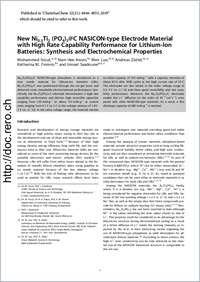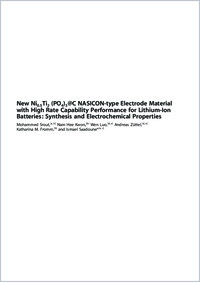New Ni0.5Ti2 (PO4)3@C NASICON-type electrode material with high rate capability performance for lithium-ion batteries: Synthesis and electrochemical properties
- Srout, Mohammed LCME, Faculty of Science and Technology, Cadi Ayyad University, Marrakesh Morocco - Department of Chemistry, University of Fribourg, Switzerland
- Kwon, Nam Hee Department of Chemistry, University of Fribourg, Switzerland
- Luo, Wen Laboratory of Materials for Renewable Energy (LMER), Institute of Chemical Sciences and Engineering, École Polytechnique Fédérale de Lausanne (EPFL) Valais/Wallis, Sion Switzerland - Empa Materials Science & Technology, Dübendorf Switzerland
- Züttel, Andreas Laboratory of Materials for Renewable Energy (LMER), Institute of Chemical Sciences and Engineering, École Polytechnique Fédérale de Lausanne (EPFL) Valais/Wallis, Sion Switzerland - Empa Materials Science & Technology, Dübendorf Switzerland
- Fromm, Katharina M. Department of Chemistry, University of Fribourg, Switzerland
- Saadoune, Ismael LCME, Faculty of Science and Technology, Cadi Ayyad UniversityMarrakesh Morocco - Mohammed VI Polytechnic University Lot 660-Hay Moulay Rachid Ben Guerir Morocco
-
2019
Published in:
- ChemSusChem. - 2019, vol. 12, no. 21, p. 4846–4853
English
Ni0.5Ti2(PO4)3/C NASICON‐type phosphate is introduced as a new anode material for lithium‐ion batteries (LIBs). Ni0.5Ti2(PO4)3/C was synthesized through the sol–gel route and delivered some remarkable electrochemical performances. Specifically, the Ni0.5Ti2(PO4)3/C electrode demonstrates a high rate capability performance and delivers high reversible capacities ranging from 130 mAh g−1 to about 111 mAh g−1 at current rates ranging from 0.1 C to 5 C in the voltage window of 1.85–3 V (vs. Li+/Li). In the same voltage range, the material reaches an initial capacity of 105 mAh g−1 with a capacity retention of about 82 % after 1000 cycles at the high current rate of 10 C. The electrodes are also tested in the wider voltage range of 0.5–3 V (vs. Li+/Li) and show good reversibility and rate capability performance. Moreover, the Ni0.5Ti2(PO4)3/C electrodes enable fast Li+ diffusion (in the order of 10−13 cm2 s−1) compared with other NASICON‐type materials. As a result, a first discharge capacity of 480 mAh g−1 is reached.
- Faculty
- Faculté des sciences et de médecine
- Department
- Département de Chimie
- Language
-
- English
- Classification
- Chemistry
- License
- License undefined
- Identifiers
-
- RERO DOC 327695
- DOI 10.1002/cssc.201902002
- Persistent URL
- https://folia.unifr.ch/unifr/documents/308344
Other files
Statistics
Document views: 71
File downloads:
- fro_nnn.pdf: 223
- fro_nnn_sm.pdf: 126

